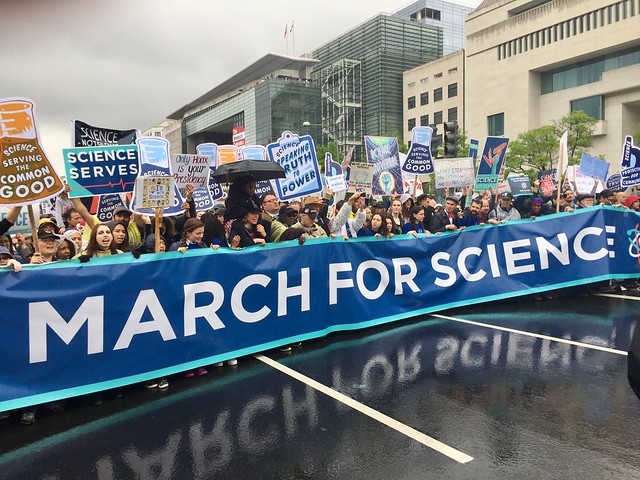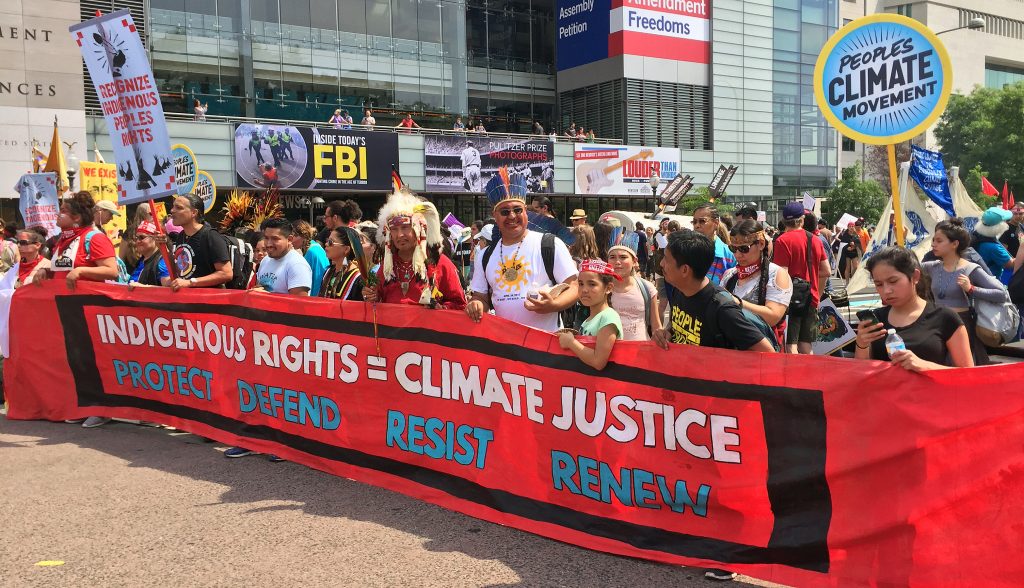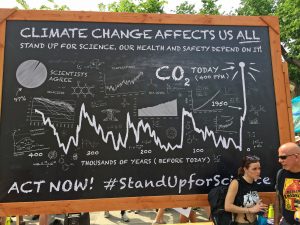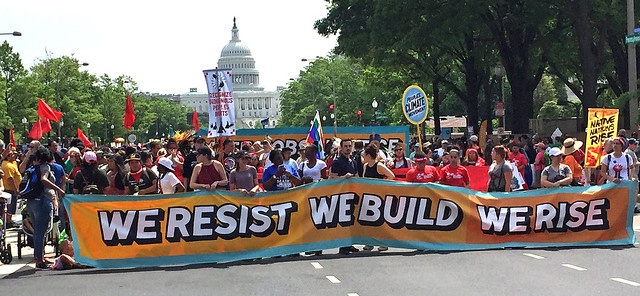Summer 2017 was extremely busy with environmental advocacy work, most of it centered around the Ready for 100 Columbus campaign and my work as a Climate Reality leader. I also participated in several progressive political events.
Ready for 100 Columbus
My work on the Ready for 100 campaign got underway in earnest this summer with two Sierra Club training conferences: the National Gathering of all Ready for 100 leaders in Miami on June 21-23, and a Connect the Dots training for four Ready for 100 team members in Oakland on July 13-16. Both trips to train local activists were paid for by Sierra Club.

Aerial Art Action in Miami
The Ready for 100 National Gathering was held in Miami in conjunction with the annual meeting of the U.S. Conference of Mayors, which passed a resolution supporting cities committing to 100% renewable energy. At the gathering we got presentations on the vision for Ready for 100, creating a public narrative, campaign principles, effective practices, roles and capacities, and community dialogues. We also did an aerial art action on Miami Beach, coordinated by John Quigley, who organized the famous aerial art action at the Eiffel Tower during the Paris Climate Conference.

El Capitan in Yosemite, Summer 2017
I was the only one from Columbus to attend the Ready for 100 training in Miami, but in July I got to take a team of four people to a Connect the Dots training in Oakland. Whereas the Miami training was more about high-level campaign principles and story, the Oakland training concentrated on the nuts and bolts of how to run a campaign. Another Columbus group attended a second Connect the Dots training in Washington, D.C., and together our teams were assigned to put together the same Connect the Dots training in Columbus in the fall.

Muir Woods, Summer 2017
Since I rarely get to the west coast, I decided to go early and use two days before the conference to tour Yosemite National Park and Muir Woods National Monument. I stayed in a hostel in downtown San Francisco and caught a daylong tour to both places. I got hundreds of great photos at both Yosemite and Muir Woods, but photos cannot do either of these two natural wonders justice. You have to go and see them for yourself.
I wasted no time in putting what I learned at these trainings into practice with the Ready for 100 campaign in Columbus. This summer I started being asked to speak about Ready for 100 at multiple events, including:
- Hands Off Public Lands rally on June 14
- Make Columbus a Climate City rally on June 19
- Columbus Green Drinks on June 28
My Ready for 100 Columbus team also organized a coalition launch on July 18, designed to reach out to supporters and like-minded advocates in other environmental groups in Central Ohio, to start building our base moving forward. About 20 people showed up, and a couple of them became core volunteers.
Climate Reality

(left to right) Me, Kristen Ricker, and Preeti Jaggi gave a presentation of “The Climate Crisis and Its Solutions” on June 17.
After mentoring at the Climate Reality training in Denver in March, I worked hard to keep up with my leadership commitments. Upon returning to Ohio, I worked with Preeti Jaggi and Kristen Ricker, two other Climate Reality leaders in Columbus, to host a presentation of the slideshow at Upper Arlington Public Library on June 17. We each took a third of the presentation and gave it to an audience of about 40. Given how much we had to fit planning, publicity, and rehearsal of the presentation between other activities, we were thrilled to get that many people.
Also this summer, Al Gore’s movie An Inconvenient Sequel: Truth to Power was released. I was invited to a special showing of the film for city leaders in Cleveland on June 24, then attended free showing in Columbus at the Wexner Center on August 2, Gateway Theater on August 3 where I spoke as part of a panel after the film, and Lennox Town Center on August 9. At the three Columbus showings, we had postcards for people to sign asking City Council to commit Columbus to 100% renewable energy. We got about 100 postcards at each event.
 Finally, in August journalist Jill Cody put out a call over the Climate Reality intranet for authors of book chapters for her forthcoming book Climate Abandoned. One of the chapters needing an author was on the “Product of Doubt.” Between school and other environmental activities, I didn’t have much time to write a book, but this is a topic I have read about extensively, and I couldn’t resist. I signed up to write the chapter, which ended up dominating my winter, spring and breaks until I turned in the 51-page manuscript in August 2018. The chapter was so substantive, covering climate denial campaigns of Exxon and the Koch brothers, that Jill broke it into three sections for the published book, which you can find here.
Finally, in August journalist Jill Cody put out a call over the Climate Reality intranet for authors of book chapters for her forthcoming book Climate Abandoned. One of the chapters needing an author was on the “Product of Doubt.” Between school and other environmental activities, I didn’t have much time to write a book, but this is a topic I have read about extensively, and I couldn’t resist. I signed up to write the chapter, which ended up dominating my winter, spring and breaks until I turned in the 51-page manuscript in August 2018. The chapter was so substantive, covering climate denial campaigns of Exxon and the Koch brothers, that Jill broke it into three sections for the published book, which you can find here.
Progressive Politics
This summer I have not been able to do much direct political organizing, but I did attend three memorable events: the People’s Summit held June 9-11 in Chicago, a Bernie Sanders rally to save our health care on June 25 in Columbus, and the Mobilize 88 summit held July 22-23 at Deer Creek Park in Ohio.

I was somewhere to the right in the upper deck of this audience witnessing history.
The People’s Summit, organized by Our Revolution, People for Bernie, and the National Nurses Union, was full of amazing and inspiring speakers like Nina Turner, Van Jones, Nomiki Konst, RoseAnn DeMoro, Naomi Klein, Michael Moore, Linda Sarsour, Thomas Frank, Larry Krasner, Chokwe Lumumba, and of course Bernie Sanders. You can see the recorded sessions here.
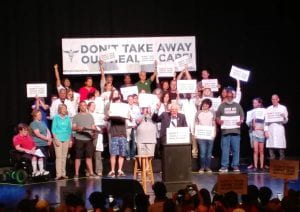
Bernie Sanders leads a rally to save our health care in Columbus on June 25, 2017. That’s my friend Puja with her arm raised on the upper left.
Bernie’s Save Health Care Rally was held inside Lifestyle Communities Pavilion, which only holds about 4,000 people, but it was packed. I worked the media table with my friend Puja Datta, who was also chosen to be on stage with Bernie. The atmosphere was electric, as local politicians Mary Jo Kilroy and Betty Sutton turned out.
Mobilize 88 featured keynotes by three women of color – Nina Turner, Anoa Changa, and Stacey Hopkins. Look up their work. Several local progressive activists also spoke. Here is coverage from Real News Network.






